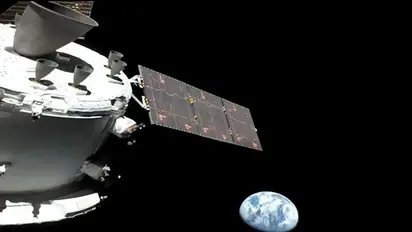NASA's Orion spacecraft shows first images of Earth on its way to Moon

Synopsis
NASA's Orion spacecraft, designed to "carry humans to Moons and beyond" shared, sent first images from space hours after its thunderous launch on space agency's mightiest rocket in a dress rehearsal for astronaut flights.
The Orbit Launch System powered by 4 million kilogrammes of thrust rocketed into space and put the Orion spacecraft on a route to the Moon hours after it was launched from Cape Canaveral in Florida. The mission began the journey for humans to return to the lunar surface, which has been uninhabited for more than 50 years since the last Apollo-era astronauts set foot there.
The onboard camera has provided an extraordinary perspective of Earth as seen from orbit, with Orion currently on a path towards the Moon. The planet is seen hanging in the background and is just partially lighted. Cameras on the rocket and spacecraft will gather important engineering data and provide a distinctive viewpoint of humanity's return to the Moon.
Also Read | NASA's next-generation Artemis-1 mission finally lifts off 50 years after Apollo
The image, which was taken after the trans-lunar injection from a distance of 58,000 miles from Earth, is reminiscent of earlier photographs of Earth taken by astronauts on missions to the Moon during the Apollo period. Eight cameras on the SLS and sixteen on the Orion were launched as part of a total of 24 cameras, according to NASA, to capture key mission activities such launch, ascent, solar array deployment, external rocket inspections, landing, and recovery.
Also Read | Out-of-control Chinese rocket debris crashes in the Pacific Ocean
In order to maximise the amount of sunlight that is captured and turned into electricity to power Orion, the solar panels have been built with the ability to move in relation to the rest of the spaceship.
The Orion cameras will capture photos and video in a range of resolutions, from standard definition to high definition and up to 4K. Callisto, a technology demonstration camera with three in-cabin cameras that will be used to test video conferencing capabilities from lunar orbit, is also carried by Orion.
The first woman and the first person of colour will touch down on the Moon through NASA's Artemis missions, opening the door for a sustained lunar presence and acting as a stepping stone for humans travelling to Mars.
Also Read | China to send monkeys into space to study zero-gravity reproduction: Report